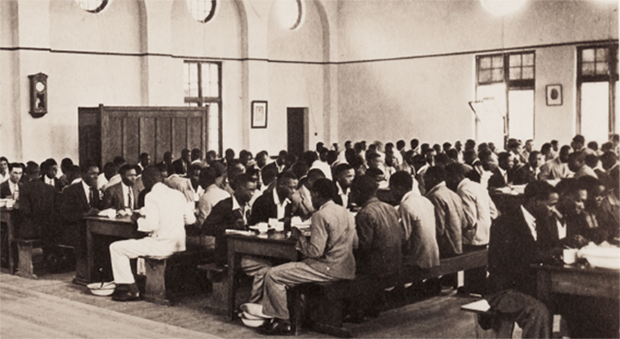
Fort Hare: from garrison to bastion of learning Luvuyo Wotshela
KKM Review Publishing
R249.95 at all major book stores
In this new book, the history of Fort Hare over the past century is revealed.
Explore the story behind the Eastern Cape university where the futures of South African greats like Oliver Tambo, Desmond Tutu and Nelson Mandela were shaped:
Although the first generation of students who studied at the college were mainly from the African elite, particularly children of income-earning professionals, chiefs, or those associated with churches and mission education, there were others who came from needy backgrounds.
In the typical style of a missionary civilisation endeavour, predominantly Victorian social activities were encouraged.
Students were exposed to a wide range of recreational events and sport, usually organised by the hostels.
Most recreational activities and games were typically English: debating, ballroom dancing, rugby, cricket, football, softball tennis, weightlifting and boxing.
Rugby teams excelled in several competitions, some of which were held against visiting teams, and generally all these games provided a competitive, albeit leisurely, recreational environment.
The most serious aspect of college life was academic work, and most of the students were primed for that challenge.
There were only 20 in the first group of students in 1916, drawn from different parts of the Union of South Africa, Basutoland and Bechuanaland.
They consisted of 16 African men, two white men and two African women.
None of the entire group had at the time matriculated, and in fact no one had more than two years of secondary schooling on admission.
Some of this group wanted to prepare for university entry, but the majority had to augment their post-primary education in order to be eligible for degree registration, or even to study for diplomas in Commerce or Agriculture.
It was only after a period of eight years after the inauguration of the college that the first students were awarded degrees conferred by the University of South Africa, as the examining body.
They were Zachariah Keodirelang Matthews and Edwin Ncwana who obtained the Bachelor of Arts degree in 1924.
Matthews, or ‘ZK’ as he fondly became known, came from a humble background.
Born in Kimberley in 1901, the son of a mineworker, he was strongly influenced by his cousin, Sol Plaatje, who also was an intellectual, to pursue his education.
Milner Langa Kabane, born in 1900 into a Wesleyan family near Butterworth, graduated shortly after ZK Matthews and Edwin Ncwana with a Bachelor of Arts and teaching diploma in 1925.
One of the earliest women students, who came to Fort Hare in 1918 with a post-primary teacher’s qualification at the age of 18 to study matric, and matriculated in 1921, was Gertrude Ntlabathi.
She was born in Hewu, south of Queenstown, and was also from a Christian family.
Ntlabathi would become the first African woman to graduate with a Bachelor of Arts degree in 1928, having also completed a teaching diploma.
By then the council had already made the decision to admit coloured and Indian students to the college.
Ntlabathi’s period at Fort Hare coincided with that of Jane Gool, born in 1902, and her younger sister Zobeida, who came from a Cape Town Muslim family to study Economics at Fort Hare in 1922.
In the same period, John M Noah, born in 1903, also from a coloured family in Mthatha, came to study matric in 1924 and completed a Bachelor of Arts degree in 1929.
His contemporary, Arthur D Lazarus, also born in 1903 and originating from Dannhauser in Natal, completed matric in 1925 and graduated with a Bachelor of Arts degree in 1930.
Noah and Lazarus became the first coloured and Indian students to graduate with degrees at Fort Hare.
The graduation of Ntlabathi influenced yet another generation of women to study at Fort Hare.
Ellen Pumla Ngozwana, born in 1911 into a Methodist family in Clarkebury near Ngcobo, first studied matric in 1928, the year Ntlabathi obtained her degree, then went on to graduate with a Bachelor of Arts in 1933.
Phyllis Ntantala, born in 1916 near Idutywa, studied for matric in 1932 and completed her teaching diploma in 1936.
By this stage, the reach of Fort Hare was, ironically (and despite the Union government’s segregation policy), not geopolitically confined to the Union of South Africa.
In addition to Basutoland (Lesotho) and Bechuanaland (Botswana), the college attracted students from the Swaziland Protectorate, colonial Southern and Northern Rhodesia (Zimbabwe and Zambia), colonial Nyasaland (Malawi), Portuguese East Africa (Mozambique), Kenya, Uganda and Tanganyika (Tanzania).
This gave the opportunity to study to students like Eliud Wambu Mathu of Kenya, born 1910, who, after attending the prominent Alliance High School in Kenya, studied and graduated with a Bachelor of Arts at Fort Hare.
Yusuf Lule of Uganda, born in 1912, had previously studied at the famous Makerere University College before coming to Fort Hare in 1936. He graduated with a Bachelor of Arts in 1939.
Although the first generation students like Matthews and Kabane were by the late 1920s/early 1930s already acquainted with African mobilisation politics (particularly those of the ANC), the ANC’s influence in the early 1930s remained small as it struggled to bridge the gap between the educated elite and the grass roots.
Earlier, in the 1920s, the Industrial Commercial Union (ICU), led by Clements Kadalie, had attempted to unite and galvanise into action the working class, effectively mobilising support among workers in growing urban areas in and around East London.
However, it remained fairly detached from the rural areas and mission settlements that housed most Fort Hare students.
Besides, support for the ICU had waned by 1930, almost concurrently with challenges besetting ANC leadership, as shown in the defeat of an ephemeral Josiah Gumede presidency by Pixley Seme at the 1930 Bloemfontein Conference.
Nevertheless, Fort Hare was drawn, through Davidson Don Tengo Jabavu, into the struggle against Prime Minister Hertzog’s notoriously racist ‘Native Bills’ at that time.
Drafted in the 1930s, these focused on the consolidation of the ‘native reserves’ so as to render Africans foreigners outside the reserves, in preparation for the final elimination of the ‘liberal’ Cape African franchise.




 Publications
Publications
 Partners
Partners













